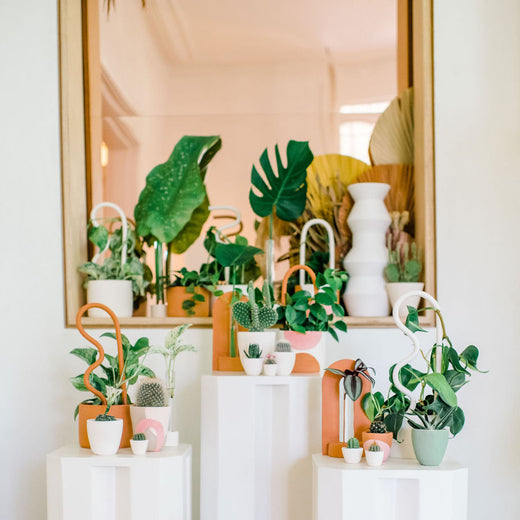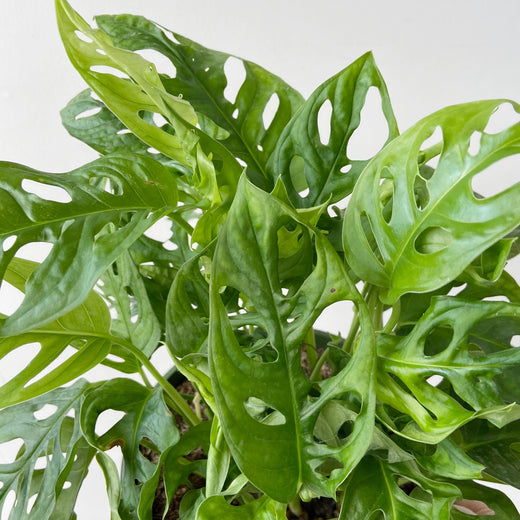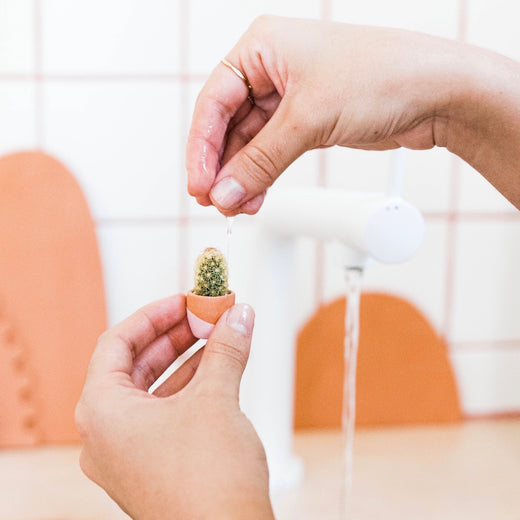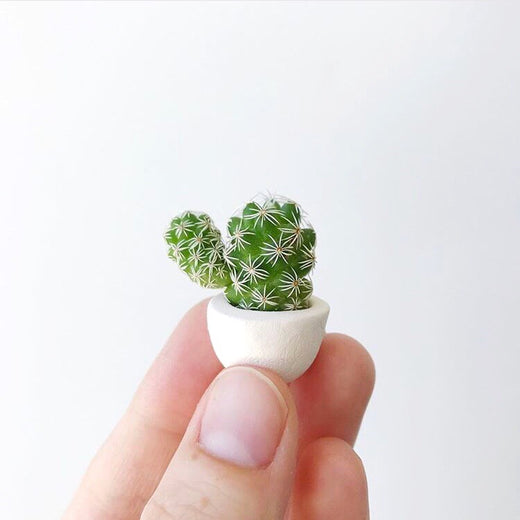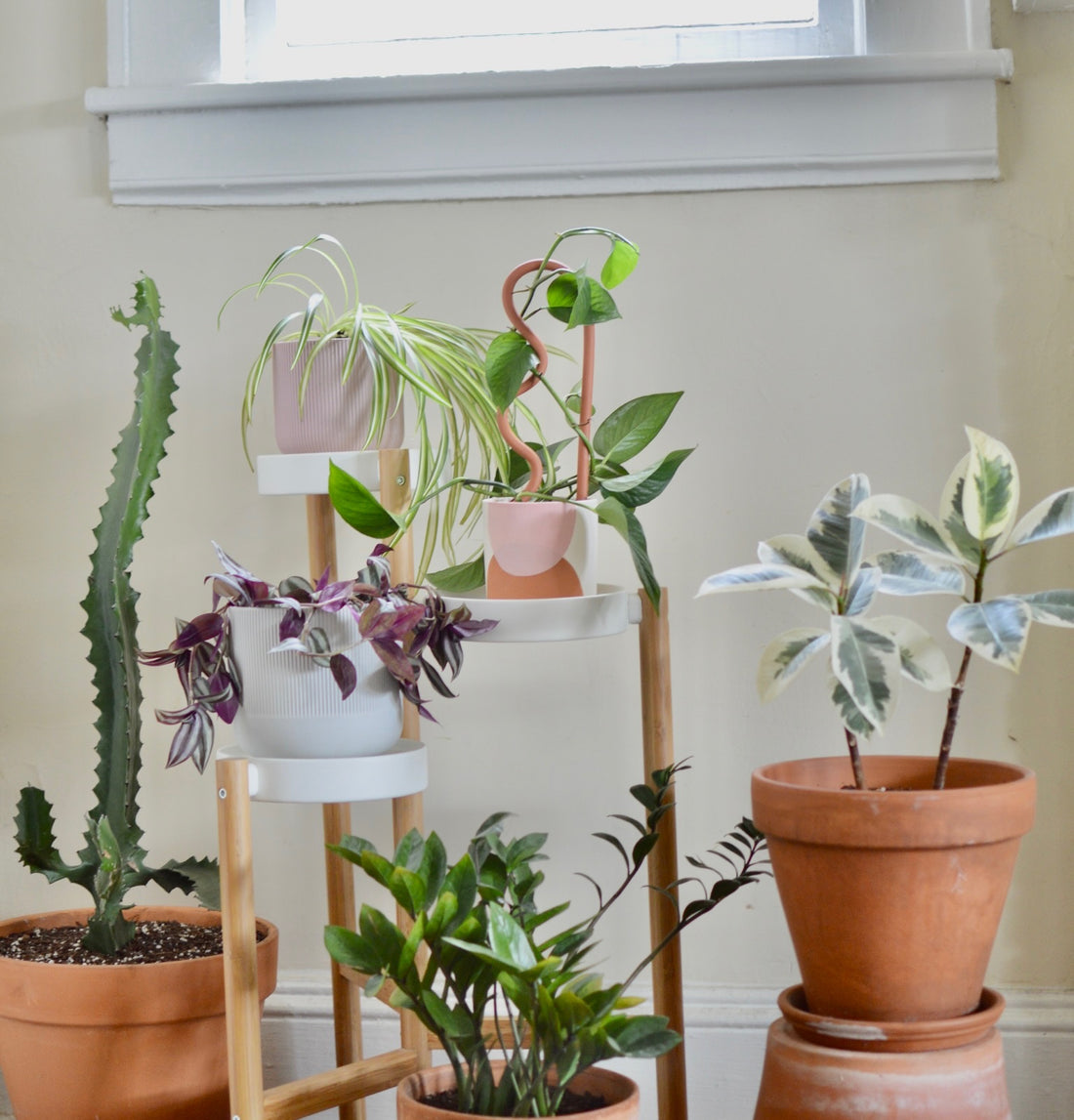The 4 planter types + the pros and cons of each for thriving plants!
Here at Tierra Sol Studio, our main goal is for you to have your plants set up to thrive with the lowest amount of maintenance possible. And we believe that setting your plants up for success from the start is what allows for a long and happy plant parenthood.
One of our biggest secrets to plant happiness is replicating the natural environment of the plant as much as possible and two of the main ways we do this is with the soils we mix and the planters we design, handmake, and test to meet the needs of each plant type.
Back when we were plant killers, we just bought plants and kept them as is, assuming that plants would do well in the pots they were sold in. What we later learned is that, (capitalism lol) of course, plants are sold in ways that make them move the fastest in the cheapest possible way for the company selling them (especially at big box stores).
Bottom line - this is why people feel like they are plant killers.
And this is why there are shelves of dying plants in that clearance corner and carts of dead plants being pushed out to the dumpsters. 😱

The whole point of what we do is to do all the work for you…
To make sure your plants are set up properly so they will thrive (instead of struggling to survive) and you have the confidence to have plants!
So what do you do when you want a plant that we don’t grow? This happens to us too!
Option A: Our suggestion is that if your plant didnt come from us as a kit - where we do all the research on the plant, make their planter for their needs, mix their soil for their plant type, and test specific amount of water and care instructions - that you should do as much of that on your own to make sure your new plant will thrive.
Option B: Email me and Annsley at care@tierrasolstudio.com and we would be happy to help!
We don’t make planters in every size or for every plant type. We only grow the hardiest plants and make planters for those specific needs: philodendron, pothos, monsteras, cacti, gasteria, haworthia, etc. So we also need to find some outside planters every once in a while when there is a giant bird of paradise we can’t pass up (Thanks a lot, IKEA.)
So here is our breakdown of which plant pots serve which purpose and their pros and cons:
First, before deciding what type of planter to go with, be sure you know what your plant prefers - does it like its soil wet, moist, or dry in between waterings or long periods of dry soil.
Second, all plants need their soil and roots to receive oxygen so a breathable planter is great if possible
Cache Pot
Sealed, no drainage hole *Common in stores*
Cache pots are commonly mistaken as planters but they are not meant for that purpose.
Cache pots are sealed pots with no drainage holes. They are decorative pots meant to cover a plastic growers cup and are not intended to be used like planters.
As decorative pots, their main function is aesthetic and not for the health of the plant.
This means that the watering of the plant should not happen in the cache pot, where standing water will collect at the bottom causing root rot and other issues. Instead, the plant will need to be lifted out of the planter to be cared for and returned back to the planter after watering and proper drainage.

If you love up close and personal plant work where you remove each plant from the cache pot to inspect them, water them in another location, have space for them to stay while they properly drain until the soil has the correct amount of moisture in the soil for that specific type of plant and are completely in tune with your plant’s every need, then cache pots may work well for you.
While cache pots can be cute, durable, widely available, or even free with big box store plants, cache pots hold water and do not promote oxygen flow which can result in root rot, mold, and pests even if the plant requires a lot of water.
We prefer breathable clay pots to sealed ceramic pots that do not allow for lots of oxygen and airflow to the roots of the plant.
Sealed planter with drainage hole
Sealed planters with drainage holes are similar to cache pots in that they do not have a lot of breathability, but their drainage hole does allow for some water to escape while keeping the soil very moist.
These pots have similar issues as cache pots because they still do not have much oxygen flow to the roots of the plants, still allowing for problems like overwatering, root rot, mold, and pests.
One advantage of sealed pots with a drainage hole is that, if used carefully, they can be helpful in situations where a plant needs to be watered very often or always like their soil to be moist like Cathea or Hypoestes phyllostachya.
If you do choose a sealed/glazed planter, you’ll want to make sure it has a drainage hole so that any excess water can escape and your plant and soil is not trapped with standing water.
Unsealed planter, with a drainage hole
The typical terracotta pot with saucer.
Unsealed planters with drainage holes are great for plants that like a lot of water but want to dry out between waterings like typical leafy houseplants - Bird of paradise, ficus, Tradescantia, etc.

These planters are a safe bet when it comes to plant experimentation and getting familiar with your plant. The absorbent pot and the drainage hole will help rid the soil of any excess water while ensuring the planter isn’t drying out too much.
These planters are usually not ideal for plants that like little water - such as cacti and succulents. The size of the pot and amount of water needs to be just right in order to avoid under and over watering. In a quick summary from our research we have found:
- Too little water added - the water can run through the hole or down the sides of the planter before the roots have a chance to drink.
- Too much water added - the soil will hold extra water that the plant does not need.
But they are great for large and small leafy houseplants that can handle a lot more water so that they can be properly saturated.
Unsealed planter, no drainage hole
Unsealed planters without drainage holes like ours are great for when you know exactly how much water to give your plants.
We created planters that have the benefits of terracotta like breathability with the benefits of holding the exact amount of water needed for the plant to thrive. We use different proprietary methods to create unique porosity in order to expel or keep the correct amount of water for each plant while allowing oxygen to reach the roots of the plant.
Cacti and Succulents:
Our cacti and succulent planters have more porosity than our houseplant planters in order for plants to get the right amount of water while allowing for any extra water to evaporate. Along with our rich fluffy and Perlite-free cactus and succulent soil, these pots help your plants get the water and oxygen they need, without losing all their water through the drainage holes.
Houseplants:
Our houseplant planters are also porous with no drainage hole so that they are breathable like terracotta but hold the exact amount of water we need to help your plant thrive. We use different proprietary methods for these planters to hold the right amount of moisture for houseplants than for cacti and succulents.
In our plant kits, we provide:
- the hardiest plants possible
- the planters we designed and handmade for the specific needs of each plant
- soil mixed for that plant type using the highest quality ingredients (perlite-free)
- and specific and tested instructions for watering and care
You can find our plant kits or just the planters in our shop!
And just send me an email (care@tierrasolstudio.com) if you have any questions at all about which plant kit or planter is right for you!
xo, Seana

